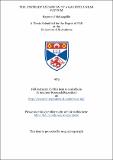Files in this item
The unsteady expansion of a gas into a near vacuum
Item metadata
| dc.contributor.advisor | Grundy, R. E. | |
| dc.contributor.author | McLaughlin, Raymond | |
| dc.coverage.spatial | 224 p. | en_US |
| dc.date.accessioned | 2018-06-12T13:25:32Z | |
| dc.date.available | 2018-06-12T13:25:32Z | |
| dc.date.issued | 1975 | |
| dc.identifier.uri | https://hdl.handle.net/10023/13956 | |
| dc.description.abstract | This thesis is concerned with the unsteady expansion of an initially uniform, stationary gas into a low density, stationary atmosphere, studied from the viewpoint of inviscid gasdynamics. It is found that, there are two regions in the k-𝜎 parameter space having distinct forms for the large time solution, when the atmospheric density is initially proportional to r⁻[super]k, r being the spatial coordinate, k being constant and 𝜎, the geometry index, has its usual meaning. First of all a constant asymptotic shock velocity is assumed and matched expansions, for large r, are constructed. Inner expansions, valid near the shock, are matched to zeroth and first orders with the outer expansions which are valid near the contact front. Zeroth order matching, which, yields the constant asymptotic shock velocity, is possible only in a restricted region of the k-𝜎parameter space and this situation is clarified by appealing to the similarity solutions which are extended to cover cases which have not been dealt with previously. In the other region of the k-𝜎 parameter space the asymptotic shock velocity is proportional to r[super]∈ where ∈, a positive constant, is found from the similarity solutions as a function of k, γ ,𝜎. An attempt is made at constructing matched asymptotic expansions for large r. The inner solution can be obtained, apart from the evaluation of certain constants, to zeroth and first orders but the outer solution is inaccessible and can only be determined from the full inviscid solution. However it is shown that there exists a solution to the outer equations which matches with the inner solution up to first order. In both cases matching of the first order inner terms to the outer solution produces an eigenvalue problem, the solution of which is not attempted here. Finally full numerical solutions of the inviscid equations, one for each case, were produced using the method of backward drawn characteristics, devised by Hartree, and it will be seen that they compare most favourably with the asymptotic analysis. | en_US |
| dc.language.iso | en | en_US |
| dc.publisher | University of St Andrews | en |
| dc.subject.lcc | QA913.M6 | |
| dc.subject.lcsh | Turbulence | en |
| dc.title | The unsteady expansion of a gas into a near vacuum | en_US |
| dc.type | Thesis | en_US |
| dc.contributor.sponsor | Science Research Council (Great Britain) | en_US |
| dc.type.qualificationlevel | Doctoral | en_US |
| dc.type.qualificationname | PhD Doctor of Philosophy | en_US |
| dc.publisher.institution | The University of St Andrews | en_US |
This item appears in the following Collection(s)
Items in the St Andrews Research Repository are protected by copyright, with all rights reserved, unless otherwise indicated.

